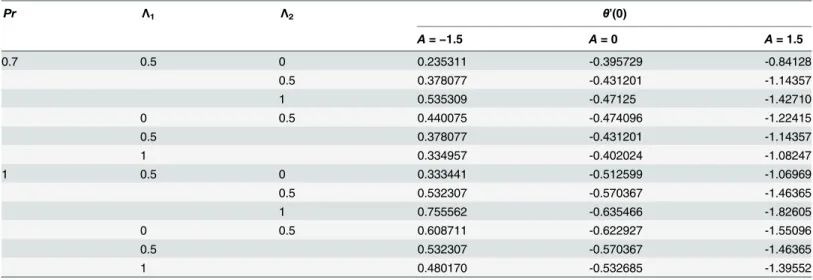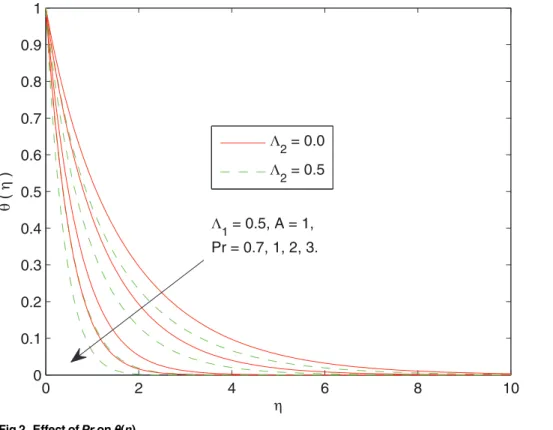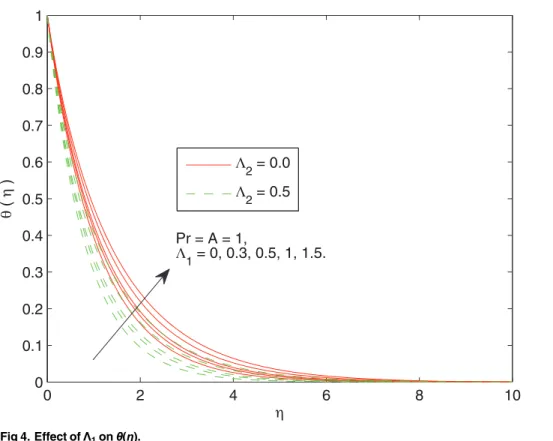Numerical Study of Cattaneo-Christov Heat
Flux Model for Viscoelastic Flow Due to an
Exponentially Stretching Surface
Junaid Ahmad Khan1, M. Mustafa2*, T. Hayat3,4, A. Alsaedi4
1Research Centre for Modeling and Simulation (RCMS), National University of Sciences and Technology (NUST), Islamabad, 44000, Pakistan,2School of Natural Sciences (SNS), National University of Sciences and Technology (NUST), Islamabad, 44000, Pakistan,3Department of Mathematics, Quaid-I-Azam University 45320, Islamabad, 44000, Pakistan,4Nonlinear Analysis and Applied Mathematics (NAAM) Research Group, King Abdulaziz University, P. O. Box 80257, Jeddah, 21589, Saudi Arabia
*meraj_mm@hotmail.com
Abstract
This work deals with the flow and heat transfer in upper-convected Maxwell fluid above an exponentially stretching surface. Cattaneo-Christov heat flux model is employed for the for-mulation of the energy equation. This model can predict the effects of thermal relaxation time on the boundary layer. Similarity approach is utilized to normalize the governing bound-ary layer equations. Local similarity solutions are achieved by shooting approach together with fourth-fifth-order Runge-Kutta integration technique and Newton’s method. Our compu-tations reveal that fluid temperature has inverse relationship with the thermal relaxation time. Further the fluid velocity is a decreasing function of the fluid relaxation time. A compar-ison of Fourier’s law and the Cattaneo-Christov’s law is also presented. Present attempt even in the case of Newtonian fluid is not yet available in the literature.
Introduction
Heat transfer phenomenon is involved in wide ranging industrial and engineering processes including nuclear reactor cooling, space cooling, energy production, biomedical applications such as magnetic drug targeting, heat conduction in tissues etc. and many others. Heat conduc-tion law proposed by Fourier [1] has been the basis to predict the heat transfer behavior in diverse practical situations. One of the major shortcomings of this model is that it produces a parabolic energy equation which means that an initial disturbance would instantly affect the system under consideration. To overcome this paradox, several modified versions of the Four-ier’s law have been introduced (see for instance [2–4] and refs. therein). Cattaneo [5], in his famous article, amended the Fourier’s law with the inclusion of relaxation time for heat flux which is defined as the time required to establish steady heat conduction once a temperature gradient is imposed. A material invariant formulation of the Cattaneo’s model was presented by Christov [6] through the consideration of Oldroyd’s upper-convected derivative. Straughan [7] used Cattaneo-Christov model to investigate thermal convection in an incompressible flow.
OPEN ACCESS
Citation:Ahmad Khan J, Mustafa M, Hayat T, Alsaedi A (2015) Numerical Study of Cattaneo-Christov Heat Flux Model for Viscoelastic Flow Due to an Exponentially Stretching Surface. PLoS ONE 10(9): e0137363. doi:10.1371/journal.pone.0137363
Editor:Bing-Yang Cao, Tsinghua University, CHINA
Received:June 28, 2015
Accepted:August 15, 2015
Published:September 1, 2015
Copyright:© 2015 Ahmad Khan et al. This is an open access article distributed under the terms of the Creative Commons Attribution License, which permits unrestricted use, distribution, and reproduction in any medium, provided the original author and source are credited.
Data Availability Statement:All relevant data are within the paper.
Funding:The authors have no support or funding to report.
Structural stability and uniqueness of the Cattaneo-Christov equations were discussed by Ciar-letta and Straughan [8]. Han et. al. [9] used Cattaneo-Christov law to explore the slip flow and heat transfer of viscoelastic fluid bounded by a stretching plate. Mustafa [10] computed both analytical and numerical solutions for rotating flow of Maxwell fluid with the consideration of Cattaneo-Christov heat flux.
The purpose of this paper is to study the boundary layer flow of upper-convected Maxwell (UCM) fluid induced by exponentially stretching sheet using Cattaneo-Christov heat flux model. Maxwell fluid is a popular viscoelastic fluid that can give the influence of fluid relaxa-tion time. On the other hand, the study of viscous flow and heat transfer above stretching sur-faces has been widely addressed research area due to its abundant applications in chemical and manufacturing processes including polymer extrusion, continuous casting of metals, extrusion of copper wires, die forging, paper production and several others. Several interesting boundary layer flow problems involving the stretching surfaces have been addressed in recent years [11–
14]. The present work is motivated towards the influence of thermal relaxation time on the vis-coelastic flow due to exponentially stretching surface. Some recent boundary layer flow prob-lems involving Maxwell fluid can be found in refs. [15–27]. The equations are first simplified through boundary layer approximations and then local similarity solution is obtained by a numerical procedure. Emphasis is given to the role of relaxation time for heat flux on the boundary layers.
Problem Formulation
Consider the steady two dimensional incompressible flow of upper-convected Maxwell (UCM) fluid over an elastic sheet located aty= 0. The sheet is stretched in its own plane with the veloc-ityUwðxÞ ¼U0e
x=L. A variable surface temperature distribution of the formT
w¼T1þT0e Ax=2L
[15] is considered in whichT0denotes the heating/cooling reference temperature. This is rea-sonable since in extrusion process, the material properties and in particular the elasticity of the extruded sheet is being pulled out by a constant force. Invoking the boundary layer approxima-tions, the equations governing the two-dimensionalflow and heat transfer of incompressible UCMfluid are expressed as below:
@u
@xþ
@v
@y¼0; ð1Þ
u@u
@xþv
@u
@yþl1 u 2@
2 u
@x2þv 2@
2 u
@y2þ2uv
@2 u
@x@y
¼n@
2 u
@y2; ð2Þ
ðrcpÞ u @T
@xþv
@T
@y
¼ r:q; ð3Þ
whereuandvdenote the velocity components along thex—andy—directions respectively,vis the kinematic viscosity,λ1is thefluid relaxation time,Tis the localfluid temperature andqis the heatflux which satisfies the following relationship [3].
qþl2
@q
@tþV:rq q:rVþ ðr:VÞq
¼ krT; ð4Þ
in whichλ2is the relaxation time for heatflux,Vis the velocity vector andkis the thermal
et al. [6])
u@T
@xþv
@T
@yþl2 u
@u
@xþv
@u
@y
@
T
@xþ u
@v
@xþv
@v
@y
@
T
@yþu 2@
2 T
@x2 þv 2@
2 T
@y2 þ2uv
@2 T
@x@y
¼a@
2 T
@y2; ð5Þ
whereα(=k/ρcp) is the thermal diffusivity. The boundary conditions are imposed as below:
u¼UwðxÞ ¼U0ex
=L; v¼0; T¼T
wðxÞ ¼T1þT0eAx
=2L
aty¼0;
u!0; T!T
1 as y! 1:
ð6Þ
Using the following similarity transformations [15]
Z¼
ffiffiffiffiffiffiffiffi U0
2nL
r ex=2L
y; u¼U0ex=Lf0; v¼
ffiffiffiffiffiffiffiffi
nU0
2L
r ex=2L
ðf þZf0Þ; y¼ T T1
Tw T1
; ð7Þ
Eq (1) is identically satisfied and Eqs (2)–(6) take the following forms
f‴ 2f02
þff@þL
1 3ff 0 f@þZ
2f
02 f@ 1
2f
2
f‴ 2f03
¼0; ð8Þ
1
Pry
@þfy0
Af0yþ L2
2 ½A ff
@y Að2þAÞf02
yþ ð1þ2AÞff0y0 f2
y@ ¼0; ð9Þ
fð0Þ ¼0; f0ð0Þ ¼1; yð0Þ ¼1;
f0ð1Þ !0; yð1Þ !0; ð10Þ
whereL1 ¼l1U0ex=L=Lis the non-dimensionalfluid relaxation time,L2¼l2U0ex=L=Lis the
non-dimensional thermal relaxation time andPr=v/αis the Prandtl number.
It is important to point out through the Eqs (8)–(10) that whenΛ1= 0, the case of
Newto-nian fluid is obtained. FurtherΛ2= 0 corresponds to the case of classical Fourier’s heat
conduc-tion law.
1. Numerical method
This yields the following: x0 1 x0 2 x0 3 x0 4 x0 5 0 B B B B B B B @ 1 C C C C C C C A ¼ x2 x3
2x22
x1x3 L1 3x1x2x3þ
Z
2x2
2
x3 2x23
=
1 L12 x1
2
x5
x1x5þAx2x4 L2
2 ðAx1x3x4 Að
2þAÞx22
x4þ ð1þ2AÞx1x2x5Þ
=
1 Pr L2 2 x1 2 0 B B B B B B B B B B B @ 1 C C C C C C C C C C C A ;ð11Þx1ð0Þ
x2ð0Þ
x3ð0Þ
x4ð0Þ
x5ð0Þ
0 B B B B B B B @ 1 C C C C C C C A ¼ 0 1
f@ð0Þ
1
y0ð0Þ
0 B B B B B B B @ 1 C C C C C C C A ; ð12Þ
Eq (11)subject to the initial conditionsEq (12)are integrated numerically using fifth-order Runge Kutta method through suitable choice of the unknown initial conditionsu1 =f”(0) and
u2=θ’(0). The values of these conditions are then iteratively estimated through Newton’s method such that solutions satisfy the boundary conditions at infinity (given inEq (10)) with the error less than 10−5.
2. Results and discussion
Physical interpretation to the behavior of the embedded parameters is assigned in this section. InTable 1we presented the numerical values of wall temperature gradient for different values of embedded parameters. We notice thatθ’(0) is directly proportional to the dimensionless relaxation timeΛ1. However it appears to decrease upon increasing the fluid relaxation time.
Notably, the value ofθ’(0) is negative whenA=−1.5 revealing the reverse flow near the wall
which will be explained later. There is a significant growth in the wall temperature gradient
θ’(0). WhenAis incremented. WhenAenlarges, this leads to larger a surface temperature and hence larger heat transfer rate from the sheet.
Fig 1illustrates the effects of non-dimensional fluid relaxation time on the hydrodynamic boundary layer. An increase inΛ1may be regarded as increase in fluid viscosity. This increased
viscosity opposes the fluid motion and consequently the velocity decreases. It is also clear that velocity profiles are tilted towards the stretching wall whenΛ1is increased which means that
boundary layer thickness is an increasing function ofΛ1. The obtained results are in
accor-dance with the results of Han et al. [6] in which linearly stretching sheet was considered.
Fig 2portrays the behavior of Prandtl numberPron the thermal boundary layer with and without the consideration of thermal relaxation time. The behavior ofPronθis qualitatively similar in both the cases i.e. the temperature and thermal boundary layer thickness both are found to decrease upon increasingPr. Notably the variation in temperatureθis similar in mag-nitude in both Fourier and Cattaneo-Christov heat flux models. Physically, the Prandtl number
InFig 3the impact of temperature exponentAon the temperature profile is sketched. This Figdepicts an interesting phenomenon of“Sparrow-Gregg hill (SGH)”for negative
tempera-ture exponentAin which temperatureθfirst approaches to a maximum and then
exponen-tially descends to zero whenηis increased. This means that for some negativeA, one expects reverse heat flow in the vicinity of the sheet. This result is consistent with the findings of Magyari and Keller [7] for the Fourier heat conduction law. With an increase in positive/
Table 1. Computational results of wall temperature gradientθ’(0) for different values of parameters.
Pr Λ1 Λ2 θ’(0)
A=−1.5 A= 0 A= 1.5
0.7 0.5 0 0.235311 -0.395729 -0.84128
0.5 0.378077 -0.431201 -1.14357
1 0.535309 -0.47125 -1.42710
0 0.5 0.440075 -0.474096 -1.22415
0.5 0.378077 -0.431201 -1.14357
1 0.334957 -0.402024 -1.08247
1 0.5 0 0.333441 -0.512599 -1.06969
0.5 0.532307 -0.570367 -1.46365
1 0.755562 -0.635466 -1.82605
0 0.5 0.608711 -0.622927 -1.55096
0.5 0.532307 -0.570367 -1.46365
1 0.480170 -0.532685 -1.39552
doi:10.1371/journal.pone.0137363.t001
Fig 2. Effect ofPronθ(η).
doi:10.1371/journal.pone.0137363.g002
Fig 3. Effect ofAonθ(η).
negative temperature exponent parameterA, we observe a sharp growth in wall slope of tem-perature function.
Fig 4displays the influence ofΛ1on thermal boundary layer. Stronger viscous force
associ-ated with the largerΛ1resists the flow and enhances the temperature. This leads to the
conclu-sion that temperature in viscoelastic fluid is greater than the viscous fluid. InFig 5the effect of non-dimensional thermal relaxation timeΛ2. on the temperature distribution is sketched. We
observe that temperatureθhas inverse relationship with the thermal relaxation time. We also notice that temperatureθapproaches the free stream condition at shorter distances above the sheet for biggerΛ2. Notably, the variation in temperatureθwith thermal relaxation time is of
similar magnitude in Newtonian and Maxwell fluids.
Fig 6presents the wall temperature gradient as a function of relaxation timeΛ2at different
values ofΛ1.θ’(0) linearly increases with an increment inΛ2whereas it appears to decrease
whenΛ1is increased.Fig 7plotsθ’(0) against the Prandtl number with the variations inΛ1and
Λ2. This Fig is complementing the numerical results ofθ’(0) given inTable 1. The profiles of
θ’(0) are nearly a straight line revealing that heat transfer rate grows linearly whenPris aug-mented. We observe thatθ’(0) approaches to zero for vanishing Prandtl number.
3. Concluding remarks
Cattaneo-Christov heat flux model is used to describe the heat transfer in viscoelastic flow induced by an exponentially stretching sheet. The major points of this study may be summa-rized as under:
1. Hydrodynamic boundary layer is thinner in viscoelastic fluid when compared with the vis-cous fluid.
Fig 5. Effect ofΛ2onθ(η). doi:10.1371/journal.pone.0137363.g005
2. Temperature and thermal boundary layer thickness are decreasing functions of relaxation timeΛ2.
3. Interesting Sparrow-Gregg Hills (SGH) for the temperature distribution exist for negative
temperature exponentA.
4. The behaviors of parameters in Cattaneo-Christov model are qualitatively similar to those in Fourier’s heat conduction law.
5. The present consideration for the Newtonian fluid case can be recovered by choosing Λ1= 0.
Author Contributions
Analyzed the data: JAK MM TH AA. Contributed reagents/materials/analysis tools: JAK MM TH AA. Wrote the paper: JAK MM TH AA.
References
1. Fourier JBJ (1822). Théorie Analytique De La Chaleur, Paris.
2. Cao BY, Guo ZY (2007). Equation of motion of a phonon gas and non-Fourier heat conduction. Journal of Applied Physics 102: 053503.
3. Dong Y, Cao BY, Guo ZY (2011). Generalized heat conduction laws based on thermomass theory and phonon hydrodynamics. Journal of Applied Physics 110: 063504.
4. Zhang MK, Cao BY, Guo YC (2013). Numerical studies on dispersion of thermal waves. International Journal of Heat and Mass Transfer 67: 1072–1082.
5. Cattaneo C (1948). Sulla conduzione del calore, Atti Semin. Mat. Fis. Univ. Modena Reggio Emilia 3: 83–101.
6. Christov CI (2009). On frame indifferent formulation of the Maxwell—Cattaneo model of finite-speed heat conduction. Mechanics Research Communications 36 481–486.
7. Straughan B (2010). Thermal convection with the Cattaneo—Christov model. International Journal of Heat and Mass Transfer 53: 95–98.
8. Ciarletta M, Straughan B (2010). Uniqueness and structural stability for the Cattaneo—Christov equa-tions. Mechanics Research Communications 37: 445–447.
9. Han S, Zheng L, Li C, Zhang X (2014). Coupled flow and heat transfer in viscoelastic fluid with Catta-neo—Christov heat flux model. Applied Mathematics Letters 38: 87–93.
10. Mustafa M (2015). Cattaneo-Christov heat flux model for rotating flow and heat transfer of upper-con-vected Maxwell fluid. AIP Advances 5: 047109.
11. Zheng L, Wang L, Zhang X (2011). Analytic solutions of unsteady boundary flow and heat transfer on a permeable stretching sheet with non-uniform heat source/sink. Communications in Nonlinear Science and Numerical Simulation 16: 731–740.
12. Zheng L, Niu J, Zhang X, Gao Y (2012). MHD flow and heat transfer over a porous shrinking surface with velocity slip and temperature jump. Mathematical and Computer Modelling 56: 133–144. 13. Zheng L, Wang L, Zhang X, Ma L (2012). Flow and heat transfer of MHD viscous fluid over an unsteady
stretching surface with radiation heat flux. Chemical Engineering Communications 199: 1–16. 14. Zheng L, Zhang C, Zhang X, Zhang J (2013). Flow and radiation heat transfer of a nanofluid over a
stretching sheet with velocity slip and temperature jump in porous medium. Journal of the Franklin Insti-tute 350: 990–1007.
15. Magyari E, Keller B (1999). Heat and mass transfer in the boundary layers on an exponentially stretch-ing continuous surface. Journal of Physics D: Applied Physics, 32: 577–585.
16. Zheng LC, Wang KN, Gao YT (2011). Unsteady flow and heat transfer of a generalized Maxwell fluid due to a hyperbolic sine accelerating plate. Computers & Mathematics with Applications 61: 2209–
2212.
17. Abel MS, Tawade JV, Nandeppanavar MM (2012). MHD flow and heat transfer for the upper-convected Maxwell fluid over a stretching sheet. Meccanica 47: 385–393.
18. Hayat T, Mustafa M, Shehzad SA, Obaidat S (2012). Melting heat transfer in the stagnation‐point flow of an upper‐convected Maxwell (UCM) fluid past a stretching sheet. International Journal for Numerical Methods in Fluids 68: 233–243.
19. Shateyi S (2013). A new numerical approach to MHD flow of a Maxwell fluid past a vertical stretching sheet in the presence of thermophoresis and chemical reaction. Boundary Value Problems 2013: 1–
14.
20. Shehzad SA, Alsaedi A, Hayat T (2013). Hydromagnetic steady flow of Maxwell fluid over a bidirec-tional stretching surface with prescribed surface temperature and prescribed surface heat flux. Plos One 8: e68139. doi:10.1371/journal.pone.0068139PMID:23874523
21. Abbasbandy S, Hayat T, Alsaedi A, Rashidi MM (2014). Numerical and analytical solutions for Falkner-Skan flow of MHD Oldroyd-B fluid. International Journal of Numerical Methods for Heat & Fluid Flow 24: 390–401.
22. Hsiao KL (2014). Conjugate heat transfer for mixed convection and Maxwell fluid on a stagnation point. Arabian journal for science and engineering 39: 4325–4332.
23. Hayat T, Shehzad SA, Alsaedi A (2014). MHD three-dimensional flow of Maxwell fluid with variable thermal conductivity and heat source/sink. International Journal of Numerical Methods for Heat and Fluid Flow 24: 1073–1085.
24. Hayat T, Farooq M, Alsaedi A (2014). Melting heat transfer in the stagnation-point flow of Maxwell fluid with double-diffusive convection. International Journal of Numerical Methods for Heat and Fluid Flow 24: 760–774.
25. Awais M, Alsaedi A, Hayat T (2014). Time-dependent flow of UCM fluid with chemical reaction, ther-mal-diffusion and diffusion-thermo effects. International Journal of Numerical Methods for Heat and Fluid Flow 24: 483–497.
26. Mustafa M, Khan JA, Hayat T, Alsaedi A (2015). Sakiadis flow of Maxwell fluid considering magnetic field and convective boundary conditions. AIP Advances 5: 027106.





